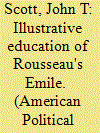| Srl | Item |
| 1 |
ID:
121119


|
|
|
|
|
| Publication |
2013.
|
| Summary/Abstract |
The location of a government's capital can profoundly influence the nature and quality of political representation. Yet scholars know very little about what drives the siting of political capitals. In this article, we examine the location and relocation of political capitals in the United States, including the choice of Washington, DC, as the nation's capital and the location and relocation of capitals in the 48 contiguous American states. We argue that the location of capitals in the United States followed a systematic pattern in accord with the theory of representative government developed in the new nation, especially as articulated by Madison. Based on an empirical analysis of historical census and political boundaries data from 1790 to the present, we find that decision makers consistently tended to locate-and especially relocate-the seat of government as near as possible to the population centroid of the relevant political jurisdiction, consistent with the principle of equal representation of citizens. Our analysis contributes to the study of institutional design and change, especially in the area of American political development, as well as to a burgeoning literature on the effects of geographical factors on political outcomes.
|
|
|
|
|
|
|
|
|
|
|
|
|
|
|
|
| 2 |
ID:
133943


|
|
|
|
|
| Publication |
2014.
|
| Summary/Abstract |
Rousseau's mission as an author was to make his readers see what he saw in his philosophical "illumination," yet his task is a paradoxical one, for he must persuade his readers that they are deceived by what they see before their own eyes and must learn to see anew. In order to transform the perspective of his reader, Rousseau throughout his works uses visual imagery and rhetorical devices invoking vision that represents both the correct view of human nature and virtue and the obstacles to learning to see ourselves properly. As a former engraver's apprentice, he was particularly interested in educating his reader through actual images such as frontispieces or illustrations. The aim of this article is to offer an interpretation of the engravings that illustrate Emile, or On Education, in order to investigate how Rousseau educates his reader through challenging the reader's preconceptions concerning human nature and replacing traditional exemplars of human nature and virtue with a new exemplar seen in his imaginary pupil.
|
|
|
|
|
|
|
|
|
|
|
|
|
|
|
|